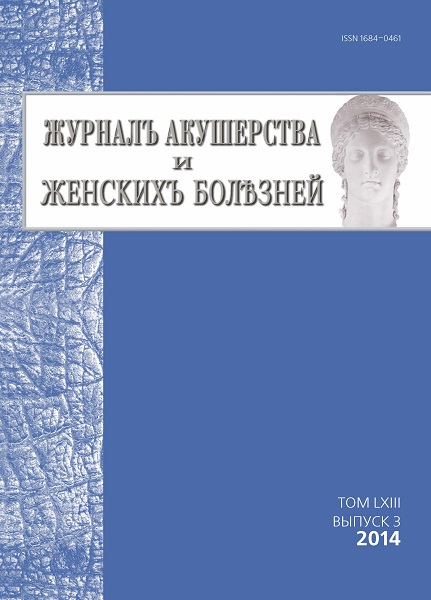Клиническая ценность дородовой диагностики крупного плода по данным ультразвуковых исследований
- Авторы: Баева И.Ю.1
-
Учреждения:
- Оренбургская государственная медицинская академия
- Выпуск: Том 63, № 3 (2014)
- Страницы: 12-20
- Раздел: Статьи
- Статья получена: 15.09.2014
- Статья опубликована: 15.09.2014
- URL: https://journals.eco-vector.com/jowd/article/view/2655
- DOI: https://doi.org/10.17816/JOWD63312-20
- ID: 2655
Цитировать
Полный текст
Аннотация
Цель исследования - установить диагностическую ценность ультразвукового исследования в дородовой диагностике макросомии у женщин без сахарного диабета и определить ее влияние на исход родов. Материалы и методы. Было проведено ретроспективное когортное исследование по материалам Оренбургского муниципального перинатального центра и городского родильного дома № 2 за 2006-2012гг. Исследовано 3760 случаев одноплодной беременности, закончившейся живорождением в срок. Ультразвуковая оценка веса плода проводилась по формуле Hadlock’s за 3-7 дней до родов. При сравнении веса плода, полученного при ультразвуковом исследовании и веса новорожденного, результаты были разделены на 4 группы: истинно-положительный, ложноотрицательный, ложноположительный, истинно-отрицательный. Для оценки диагностической ценности метода был применен ROC анализ, подсчитаны чувствительность и специфичность метода, прогностическая ценность положительного и отрицательного результатов, индекс точности. Сравнение 2-х групп было проведено с помощью критерия Стьюдента, сравнение качественных признаков с помощью таблиц сопряженности с использованием χ² по методу Пирсона с поправкой Йетса. Результаты исследования. При оценке точности ультразвукового исследования в дородовом определении веса плода были получены следующие результаты: истинно-положительный (n - 147), ложноотрицательный (n - 229), ложноположительный (n - 353), истинно-положительный (n - 3031). Отсутствие статистически значимых различий в весе плода наблюдались только в группе с истинно-положительным результатом (р = 0,9). При применении ROC анализа была установлена средняя точность ультразвукового метода в прогнозировании макросомии (Area under ROC curve, AUC - 0,7295 (95 % CI: 0,695-0,781) Установлена высокая специфичность (93,5 %), но низкая чувствительность (39 %) ультразвукового исследования в дородовой диагностике макросомии. Частота кесарева сечения в группе с истинно-положительными результатами составила 40 %, с истинно-отрицательными - 16 %. При ложноположительной оценке макросомии частота кесарева сечения статистически значимо увеличивалась до 30 % в сравнении с ложноотрицательной - 16 % (р < 0,05). В случае ложноотрицательных результатов статистически значимо увеличивались случаи родового травматизма матери и плода. Заключение. Ультразвуковая фетометрия в дородовой диагностике крупного плода обладает средней степенью точности. Антенатальная диагностика крупного плода способствует увеличению частоты кесарева сечения. Недооценка веса плода приводит к увеличению родового травматизма матери и плода.
Ключевые слова
Полный текст
Об авторах
Ирина Юрьевна Баева
Оренбургская государственная медицинская академия
Email: baeva37@mail.ru
к. м. н., ассистент кафедры акушерства и гинекологии
Список литературы
- Белоусов М. А., Титченко Л. И. Анализ ошибочных прогнозов массы плода по данным ультразвуковой фетометрии. Акушерство и гинекология. 1991; № 5: 19-21.
- Демидов В. Н., Бычков П. А., Логвиненко А. В., Воеводин С. М. Ультразвуковая биометрия (справочные таблицы и уравнения). М.;1990.
- Слабинская Т. В., Севостьянова О. Ю. Способ определения массы тела внутриутробного плода с макросомией в сроке доношенной беременности. Патент на изобретение № 2138200. М.; 1989.
- Медведев М. В. Ультразвуковая фетометрия: справочные таблицы и номограммы. М.: РАВУЗДПГ; 2002.
- Akinola S. S., Oluwafemi K., Ernest O. O., Niyi O. M., Solomon O. O., Oluwagbemiga O. A., Salami S. S. Clinical versus sonographic estimation of foetal weight in southwest Nigeria. J. Health. Popul. Nutr. 2007; 25 (1):14-23.
- Bricker L., Neilson J. P. Routine ultrasound in late pregnancy (after 24weeks gestation) (Cochrane Review). In: The Cochrane Library. Update Software. Level I. Oxford; 2000: Issue 2.
- Boulet S. L., Salihu H. M., Alexander G. R. Mode of delivery and birth outcomes of macrosomic infants. J. Obstet. Gynaecol. 2004; 24 (6): 622-9.
- Boulvain M., Stan C., Irion O. Elective delivery in diabetic pregnant women (Cochrane Review). In: The Cochrane Library. Update Software. Oxford; 2000: Issue 2.
- Campbell S., Thomas A. Ultrasound measurement of the fetal head to abdominal circumference ratio in the assessment of fetal growth retardation. Br. J. Obstet. Gynaecol. 1977; 84: 165-74.
- Chaabane K., Trigui K., Louati D., Kebaili S., Gassara H., Dammak A., Amouri H., Guermazi M. Antenatal macrosomia prediction using sonographic fetal abdominal circumference in South Tunisia. Pan. Afr. Med. J. 2013; 14: 111.
- Hadlock F. P., Harrist R. B., Carpenter R. J., Deter R. L., Park S. K. Sonographic estimation of fetal weight. The value of femur length in addition to head and abdominal measurements. Radiology. 1984;150: 535-40.
- Harlev A., Walfisch A., Bar-David J., Hershkovitz R., Friger M, Hallak M. Maternal estimation of fetal weight as a complementary method of fetal weight assessment: a prospective clinical trial. J Reprod Med. 2006; 51 (7): 515-20.
- Hillier C. E., Johanson R. B. Worldwide survey of assisted vaginal delivery. International journal of gynecology and obstetrics 1994;47 (2): 109-14.
- Lahmann P. H., Wills R. A., Coory M. Trends in birth size and macrosomia in Queensland Australia from 1988 to 2005. Pediatr. Perinat. Epidemiol. 2009; 23 (6): 533-41.
- Mazouni C., Rouzier К., Ledu К., Heckenroth H., Guidicelli B., Gamerre H. Development and internal validation of a nomogram to predict macrosomia. Ultrasound Obstet. Gynecol. 2007; 29 (5): 544-9.
- Neilson J. P. Symphysis-fundal height measurement in pregnancy (CochraneReview). In: The Cochrane Library. Update Software. Oxford; 2000: Issue 2.
- Parry S., Severs C. P., Sehdev H. M., Macones G. A., White L. M., Morgan M. A. Ultrasonographic prediction of fetal macrosomia. Association with cesarean delivery. J. Reprod. Med. 2000; 45 (1):17-22.
- Sandmire H. F., DeMott R. K. The Green Bay cesarean section study. IV. The physician factor as a determinant of cesarean birth rates for the large fetus. Am. Obstet. Gynecol. 1996; 74 (5): 1557-64.
- Shephard M. J., RichardV. A., Berkovitz R. K. et al. An evaluation of two equations for predicting fetal weigth by ultrasound. Amer. J. Obstet. Gynec. 1982;12 (1): 47-54.
- Walsh C. A., Mahony R. T., Foley M. E., Daly M., O, Herlihy C. Recurrence of fetal macrosomia in non-diabetic pregnancies. J. Obstet. Gynaecol. 2007; 27 (4): 374-8.
Дополнительные файлы








